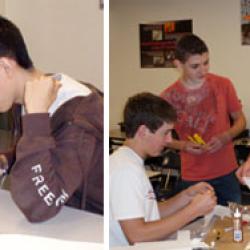Source Institutions
Add to list Go to activity
Activity link broken? See if it's at the internet archive

In this activity, learners investigate passive solar building design with a focus solely on heating. They learn how insulation, window placement, thermal mass, surface colors, and site orientation play important roles in passive solar heating. They use this information to design and build their own model houses, and test them for thermal gains and losses during a simulated day and night. Teams compare designs and make suggestions for improvements.
- Under 5 minutes
- 4 to 24 hours
- $5 - $10 per group of students
- Ages 14 - 18
- Activity, Experiment/Lab Activity, Lesson/Lesson Plan, Model, Simulation
- English
Quick Guide
Materials List (per group of students)
- 32 x 20-inches sheet of 1/8-inch foam core board (this is one half of the standard foam core board sheet, typically available with the dimensions of 1/8-inch x 32-inches x 40-inches [.32 x 81 x 102-cm]; this is about 9 sq ft or .84 sq m)
- 1 sq ft (.09 sq m) thin clear plastic
- 4 sq ft (.37 sq m) aluminum foil
- 2 sq ft (.19 sq m) thin rubber (any kind)
- 2 sq ft (.19 sq m) black fabric (any kind)
- pencils, erasers and white or graph paper for designing and graphing
- (optional) Excel software for recording and graphing group data
- Design Challenge Handout
- Analysis & Results Worksheet
- hot glue guns and/or tacky glue
- scissors
- utility knife
- thumbtacks
- scotch tape
- masking tape
- protractor
- straight edge (metal ruler)
- 300-watt light bulb(s)
- desk or clamp lamp(s) (that can safely accommodate a 300-watt light bulb)
- floor or box fan(s)
- ice
- bucket(s) or plastic container(s) (for the ice)
- thermometer(s) (alternative: use a laptop and HOBO data loggers to automatically take and record temperature readings at specified intervals)
- watch or timer(s) to determine 30-second intervals
- Teacher Testing Steps
Subjects
-
Earth and Space Science
- Earth Structure
- Earth, Moon and Sun
-
Solar System
- The Sun
-
Engineering and Technology
-
Engineering
- Architectural Engineering
- Civil Engineering
- Environmental Engineering
- Metallurgy and Materials Engineering
-
Technology
- Construction
-
Engineering
-
Physical Sciences
-
Heat and Thermodynamics
- Heat and Temperature
- Heat Transfer
- Energy
- Structure and Properties of Matter
-
Heat and Thermodynamics
-
Mathematics
-
Data Analysis and Probability
- Data Analysis
- Data Collection
- Data Representation
-
Measurement
- Rate
- Reasoning and Proof
- Representation
-
Data Analysis and Probability
-
The Nature of Technology
-
Technology and Society
- Impacts of Technology
- Technology and the Environment
-
The Design Process
- Invention and Innovation
- Troubleshooting and Maintenance
-
Technology and Society
-
The Nature of Science
-
Science and Society
- Risks and Benefits
-
The Scientific Process
- Asking Questions
- Conducting Investigations
- Gathering Data
- Formulating Explanations
- Communicating Results
-
Science and Society
Informal Categories
- Model Building
- Nature and Environment
Audience
To use this activity, learners need to:
- see
- read
- touch
Learning styles supported:
- Involves teamwork and communication skills
- Uses STEM to solve real-world problems
- Involves hands-on or lab activities
Other
Components that are part of this resource:
Includes alignment to state and/or national standards:
Includes assesments for student learning:
This resource is part of:
Access Rights:
- Free access
By:
- Integrated Teaching and Learning Program, College of Engineering, University of Colorado at Boulder
Source Collection
- TeachEngineering
Rights:
- All rights reserved, Regents of the University of Colorado, 2007
